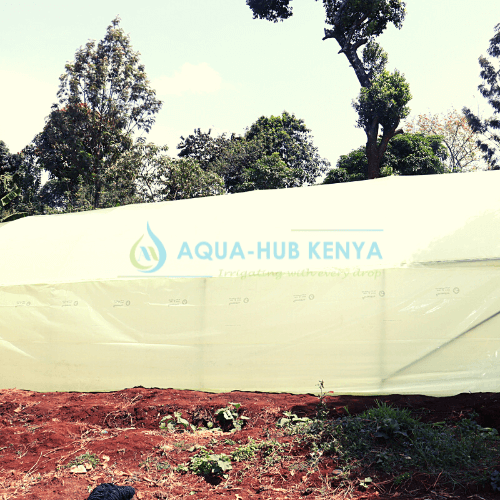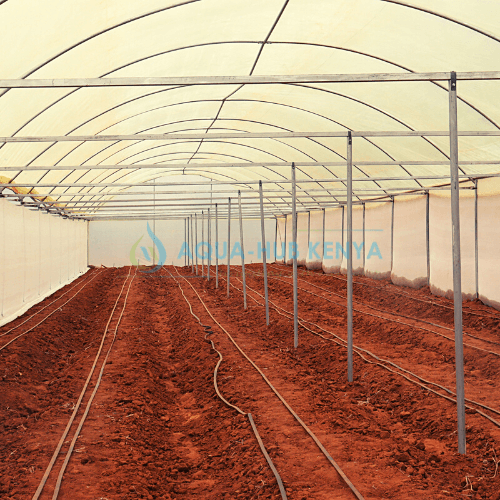Greenhouse Construction in Kenya

Greenhouse construction in Kenya includes the construction of both wooden and aluminum greenhouses for crop cultivation. If adopted, it is a very profitable investment with extremely high revenue returns for farmers. Farmers in Kenya are now considering greenhouse construction to allow them to grow crops throughout both the wet and dry seasons. Greenhouse building in Kenya necessitates exceptional abilities. Aqua Hub is one of Kenya’s largest and most reputable greenhouse construction companies, specializing in professional greenhouse construction. Our greenhouses are of the highest quality and the most cost-effective in the country.
What is greenhouse construction in Kenya?

Greenhouse construction in Kenya refers to the building of structures specifically designed to create a controlled environment for growing plants. These structures are typically made of metal frames and covered with plastic. Or other materials that allow sunlight in but keep the heat and humidity inside. Greenhouses can be applicable to grow a wide variety of crops, including vegetables, fruits, flowers, and ornamental plants.
Greenhouse construction in Kenya is increasing in popularity in recent years. This is because it allows farmers to extend their growing seasons. It also increases crop yields, and improve crop quality. It also allows farmers to grow crops that are not typically grow in the local area. Such crops include tomatoes, cucumbers, peppers, and other high-value crops.
What is the cost of greenhouse construction in Kenya?
The cost of greenhouse construction in Kenya can vary widely, depending on a number of factors. Such factors include the size of the greenhouse, the materials used, and the location of the greenhouse. However, on average, the cost of constructing a greenhouse in Kenya can range between Ksh. 150,000 to Ksh. 700,000. It’s important to note that the cost of greenhouse construction in Kenya can also vary depending on the location of the greenhouse. For example, the cost of building a greenhouse in an urban area may be higher than in a rural area due to higher labor costs and the cost of materials. Additionally, costs for electricity, water and other resources for the greenhouse operation should also be taken into account.
Factors to consider during greenhouse construction
There are several factors to consider when constructing a greenhouse in Kenya or any other location. These include:
- Location: The location of the greenhouse is an important consideration. This is because it will affect the amount of sunlight and heat that the greenhouse receives. As well as the availability of water and other resources. Greenhouses should be in an area with plenty of sunlight and good drainage, and should have protection to strong winds.
- Size and Design: The size and design of the greenhouse will depend on the type of crops you grow and the scale of the operation. It’s important to plan for adequate space for the plants and for workers to move around.
- Materials: The materials used to construct the greenhouse will affect its durability, insulation, and transparency. Plastic sheeting, polycarbonate, and glass are all common materials applicable for greenhouse construction. It’s important to choose a material that will allow sunlight to pass through, but retain heat and humidity inside the greenhouse.
- Climate control: In order to create a controlled environment for growing plants, a climate control system is necessary. This includes heating, cooling, ventilation, and shading systems to regulate temperature, humidity, and light levels.
- Water and Irrigation: An irrigation system is necessary to provide the plants with the water they need. The type of irrigation system depends on the type of greenhouse and the plants grown. Drip irrigation and micro-irrigation are common systems applicable in greenhouse farming.
- Crop Management: Consideration for crop management is important, as it will affect the type of plants grown, their arrangement, and the frequency of harvesting.
- Maintenance: The greenhouse and its equipment will require regular maintenance to ensure that it continues to function properly.

Challenges facing greenhouse construction Kenya
Greenhouse construction in Kenya, like any other location, can be challenging and requires careful planning and execution. Some of the challenges that may be faced include:
- High cost: Greenhouse construction can be expensive, especially for small-scale farmers who may not have access to credit or the necessary funds. This can make it difficult for farmers to invest in a greenhouse, even if they see the potential benefits.
- Lack of technical knowledge: Many farmers in Kenya lack the technical knowledge and skills needed to construct and operate a greenhouse. This can make it difficult for farmers to understand the complex systems and technologies involved. Hence, can lead to mistakes or problems down the line.
- Lack of access to credit or financial assistance. Many farmers in Kenya lack access to credit or financial assistance needed to invest in a greenhouse. This can make it difficult for farmers to secure the funding they need to construct a greenhouse and purchase the necessary equipment.
- Climate variability: Greenhouse farming in Kenya is affected by the climate variability and extreme weather conditions such as floods and droughts. These can cause damage to the greenhouse and can make it difficult for farmers to grow crops.
- Disease and pest issues: Greenhouses can provide an ideal environment for diseases and pests to thrive, which can make it difficult for farmers to control these problems.
- Limited market access: Limited market access is another challenge that farmers in Kenya face when growing high-value crops such as tomatoes, cucumbers, peppers, and other high-value crops in greenhouses, which can make it difficult for farmers to sell their crops.
The benefits of growing plants in a greenhouse

Growing plants in a greenhouse offers several benefits over traditional outdoor farming methods. These benefits include:
- Extended growing season: Greenhouses allow farmers to extend their growing season by providing a controlled environment for growing plants, regardless of the weather outside. This allows farmers to grow crops year-round, which can increase crop yields and improve crop quality.
- Increased crop yields: Greenhouses can provide an ideal growing environment for plants by controlling temperature, humidity, light, and other factors. This can lead to increased crop yields and improved crop quality.
- Protection from pests and diseases: Greenhouses can protect plants from pests and diseases by providing a controlled environment that is not conducive to their growth. This can reduce the need for pesticides and other chemical treatments.
- Water conservation: Greenhouses can conserve water by reducing evaporation and runoff, and by allowing farmers to control the amount of water that plants receive. This can make greenhouse farming an ideal method for regions where water is scarce.
- Energy efficiency: Greenhouses can be designed to be energy-efficient, by using natural light and passive solar heating. This can reduce the need for artificial lighting and heating, which can save farmers money on energy costs.
- Increased flexibility: Greenhouses can be used to grow a wide variety of crops, including vegetables, fruits, flowers, and ornamental plants. This allows farmers to diversify their crop production and to grow high-value crops that may not be suitable for outdoor farming.
- Increased income: Growing high-value crops such as tomatoes, cucumbers, peppers, and other high-value crops in greenhouses can increase farmers’ income by providing a stable source of income throughout the year.
- Reduced labor costs: Greenhouses can reduce labor costs by automating many of the processes involved in growing plants, such as irrigation.







